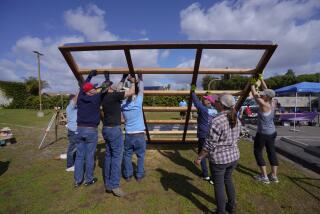Women-Only Crews Help Build Homes
- Share via
OMAHA, Neb. — By trade, Bonnie Jolly is a property tax analyst. At heart, she longs to pour concrete, pound nails and hang drywall.
Her dreams came true when she answered a call for volunteers to build a Habitat for Humanity home--with an all-women crew.
Training was included, and the 48-year-old Jolly was soon hammering to her heart’s delight. She plans to take her mother to the Mother’s Day groundbreaking in Lincoln.
“I had to laugh because last night [at a training session] I was up on a ladder in a dress and heels putting up trim and then I was down on the floor working on the baseboards,” Jolly says.
All-women projects, which Habitat for Humanity began in 1990, have proven an increasingly popular way to attract volunteers. While 100 people are needed to build the typical 1,000-square-foot home with three bedrooms and one bath, the “all-women” ads usually recruit far more.
“I was afraid that I wouldn’t have enough volunteers,” says Sandy Wolfe, the executive coordinator for the Habitat affiliate in Lincoln that is building Nebraska’s first house with a female crew. “I got more than 300, and we had to start a second house just so everyone would have a chance to get involved.”
Rookies like Jolly say they are attracted to the all-women crews because they want to learn carpentry without the intimidation factor posed by more knowledgeable men.
Veterans say they sign up to pass on their skills, and encourage more women to enter the construction trades.
Cecilia Frederick, a former construction worker, once painted her tools bright pink to foil male co-workers who used to take them to harass her. She appreciates the female camaraderie she’s experienced supervising the construction of 30 women-built houses in the St. Paul, Minn., area.
“We’ll be up there and all of a sudden, we’ll start singing Girl Scout songs and everyone joins in,” she says. “There are a lot of nail-polished bricklayers out there.”
Alice Wilcox, a 70-year-old retired librarian, says the job doesn’t require extraordinary strength. She began helping with Minneapolis-area Habitat houses three years ago and now teaches building basics to others.
“Sometimes it takes a little longer to build a house with all women because you get a lot of volunteers who don’t know what they are doing,” she says.
Wendy Birdsall hopes to learn those basics by signing up to work on the Lincoln house. The 37-year-old marketing director tried to hang a door at her home but it fell over on top of her.
“I had to call my dad to come help me. I always have to call my dad,” she says. “I wanted to be able to do it on my own.”
In 20 years, Habitat for Humanity has built 50,000 houses in 47 countries. Habitat provides the houses, simple but solid, and interest-free mortgages to low-income families.
About half of those who move into Habitat houses are single women with children, Wolfe says. Most female volunteers say they appreciate that but are mostly attracted to the work for the construction training.
Each family selected to own a Habitat house helps build it, contributing about 200 hours in “sweat equity” over three months. Wolfe says the Lincoln house will go to a couple with four children.
Frederick, the St. Paul supervisor, notes one prime difference between houses built by women and those put up by Habitat’s usual crews, which are predominantly male.
“Because most of the women are new to construction, they actually read the instructions,” she says. “Men tend to have a little more experience, so they take chances and risks that don’t always work.”
More to Read
Sign up for Essential California
The most important California stories and recommendations in your inbox every morning.
You may occasionally receive promotional content from the Los Angeles Times.









